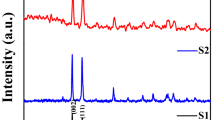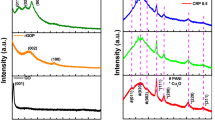Abstract
Copper oxide nanoparticles (CuONPs) have received much interest among metal oxide nanoparticles due to their various features and utilities in many disciplines, particularly electrical conductivity and energy trends. This study used sugarcane molasses as a reducing and capping agent for CuONP biosynthesis in electrical conductivity and supercapacitor applications. These nanoparticles were characterized by UV/Vis, TEM, EDX, SEM, FTIR spectra, TGA, and BET. TEM pictures revealed the development of CuONPs with mean diameters ranging from 29 to 55 nm, while SEM revealed the formation of CuONPs in nanorods. FTIR spectra confirmed the biomolecule functional moieties, which act as reducing agents for the CuONPs synthesis. Furthermore, at 417 °C, the CuONP nanocomposite produced a total weight loss of approximately 34.8%. Also, the development of copper oxide on the nanocomposite is seen in the diffraction peaks of 2 = 36.7° and 61.4°. The results reveal that the AC/CuONPs electrode has exhibited the highest capacitance and the lowest resistance among the different AC/CuONPs nanocomposites prepared at different current densities. At 1 A g−1, the specific capacitance of the AC and AC/CuONPs electrodes was 166 and 245 F g−1, respectively, and the capacitance retention was 99.5 and 100% of its initial value after 2000 cycles.













Similar content being viewed by others
Data availability
The author confirms that the article’s data supporting this study are available.
References
Ajarem JS et al (2022) Benign synthesis of cobalt oxide nanoparticles containing red algae extract: antioxidant, antimicrobial, anticancer, and anticoagulant activity. J Cluster Sci 33(2):717–728
AlSalem HS et al (2022) Physico-chemical and biological responses for hydroxyapatite/ZnO/graphene oxide nanocomposite for biomedical utilization. Mater Chem Phys 283:125988
Al-Ahmed ZA et al (2021) Electrospun nanofibrous scaffolds of ε-polycaprolactone containing graphene oxide and encapsulated with magnetite nanoparticles for wound healing utilizations. Mater Res Express 8(2):025013
El-Saye AA et al (2021) Applying nanotechnology in the synthesis of benzimidazole derivatives: a pharmacological approach. Biointerface Research in Applied Chemistry 12(1):992–1005
Kashyout AE-HB et al (2021) Enhancement of the silicon solar cell efficiency by spin-coated polythiophene films embedded with gold or palladium nanoparticles on the rear contact. ACS Omega 6(20):13077–13086
El-Bindary AA et al (2020) Metal–organic frameworks as efficient materials for drug delivery: synthesis, characterization, antioxidant, anticancer, antibacterial and molecular docking investigation. Appl Organomet Chem 34(11):e5905
Al Jahdaly BA et al (2021) Selenium nanoparticles synthesized using an eco-friendly method dye decolorization from aqueous solutions, cell viability, antioxidant, and antibacterial effectiveness. J Mater Res Technol 1:85–97
El-Desouky N et al (2021) Bio-inspired green manufacturing of plasmonic silver nanoparticles/Degussa using banana waste peduncles: photocatalytic, antimicrobial, and cytotoxicity evaluation. J Mater Res Technol 10:671–686
Fouda MMG et al (2020) Carboxymethyl cellulose supported green synthetic features of gold nanoparticles: antioxidant, cell viability, and antibacterial effectiveness. Synth Met 269:116553
Yan K et al (2021) Electrochemical synthesis of chitosan/silver nanoparticles multilayer hydrogel coating with pH-dependent controlled release capability and antibacterial property. Colloids Surf B 202:111711
Lou C et al (2021) ZnO nanoarrays via a thermal decomposition–deposition method for sensitive and selective NO 2 detection. CrystEngComm 23(20):3654–3663
Kazancioglu EO, Aydin M, Arsu N (2021) Photochemical synthesis of nanocomposite thin films containing silver and gold nanoparticles with 2-thioxanthone thioacetic acid-dioxide and their role in photocatalytic degradation of methylene blue. Surf Interfaces 22:100793
Chung S, Zhang M (2021) Microwave-assisted synthesis of carbon dot–iron oxide nanoparticles for fluorescence imaging and therapy. Front Bioeng Biotechnol 9:576
Waris A et al (2021) A comprehensive review of green synthesis of copper oxide nanoparticles and their diverse biomedical applications. Inorg Chem Commun 123:108369
Al Jahdaly BA et al (2022) Phytosynthesis of Co3O4 nanoparticles as the high energy storage material of an activated carbon/Co3O4 symmetric supercapacitor device with excellent cyclic stability based on a Na2SO4 aqueous electrolyte. ACS Omega 7(27):23673–23684
Asal HA et al (2022) Controlled synthesis of in-situ gold nanoparticles onto chitosan functionalized PLGA nanoparticles for oral insulin delivery. Int J Biol Macromol 209:2188–2196
Salem SS, Fouda A (2021) Green synthesis of metallic nanoparticles and their prospective biotechnological applications: an overview. Biol Trace Elem Res 199(1):344–370
Shoueir KR (2020) Green microwave synthesis of functionalized chitosan with robust adsorption capacities for Cr (VI) and/or RHB in complex aqueous solutions. Environ Sci Pollut Res 27(26):33020–33031
Dikshit PK et al (2021) Green synthesis of metallic nanoparticles: applications and limitations. Catalysts 11(8):902
Drummer S, Madzimbamuto T, Chowdhury M (2021) Green synthesis of transition-metal nanoparticles and their oxides: a review. Materials 14(11):2700
Taghizadeh S-M et al (2021) Biosynthesis of metals and metal oxide nanoparticles through microalgal nanobiotechnology: quality control aspects. BioNanoScience 11(1):209–226
Primožič M, Knez Ž, Leitgeb M (2021) (Bio) Nanotechnology in food science—food packaging. Nanomaterials 11(2):292
Ali S et al (2021) The avenue of fruit wastes to worth for synthesis of silver and gold nanoparticles and their antimicrobial application against foodborne pathogens: a review. Food Chem 359:129912
El-Shabasy R et al (2019) A green synthetic approach using chili plant supported Ag/Ag2O@ P25 heterostructure with enhanced photocatalytic properties under solar irradiation. Optik 192:162943
Shoueir K, Mohanty A, Janowska I (2022) The use of industrial molasses waste in the performant synthesis of few-layer graphene (and its Au/Ag nanoparticles nanocomposites): photocatalytic and supercapacitance applications. J Clean Prod 351:131540
Zhang S, Wang J, Jiang H (2021) Microbial production of value-added bioproducts and enzymes from molasses, a by-product of sugar industry. Food Chem 346:128860
Manjari G, Parthiban A, Saran S (2020) Sustainable utilization of molasses towards green synthesis of silver nanoparticles for colorimetric heavy metal sensing and catalytic applications. J Cluster Sci 31(5):1137–1145
Roukas T, Kotzekidou P (2022) From food industry wastes to second generation bioethanol: a review. Rev Environ Sci Biotechnol 21:299–329
Sharma R, Gupta H (2021) Green synthesis of silver, copper and gold nanoparticles using terminalia arjuna bark and their effect on seed germination. Nanosci Nanotechnol-Asia 11(2):243–247
Sen S, Sarkar K (2021) Effective biocidal and wound healing cogency of biocompatible glutathione: citrate-capped copper oxide nanoparticles against multidrug-resistant pathogenic enterobacteria. Microb Drug Resist 27(5):616–627
Hachemaoui M et al (2021) CuNPs-loaded amines-functionalized-SBA-15 as effective catalysts for catalytic reduction of cationic and anionic dyes. Colloids Surf, A 623:126729
Chen W-J et al (2021) Polymer-capped copper nanoparticles trigger plasmonic field for improving performance of perovskite solar cells. Synth Met 273:116675
Bagchi B et al (2022) Copper nanowire embedded hypromellose: an antibacterial nanocomposite film. J Colloid Interface Sci 608:30–39
Liang Y et al (2021) Antibacterial effect of copper sulfide nanoparticles on infected wound healing. Surg Infect 22(9):894–902
Pillai RR, Sreelekshmi P, Meera A (2022) Enhanced biological performance of green sythesized copper oxide nanoparticles using Pimenta dioica leaf extract. Mater Today: Proceedings 50:163–172
OWOEYE TF et al (2022) Biosynthesis and characterization of CuO nanoparticles from plant of Adenathera pavonina linn bark and leaves
Bitra HCR et al (2020) Synthesis and enhanced dielectric properties of copper oxidenanoparticles. Mater Chem Phys 254:123379
Pendashteh A, Mousavi MF, Rahmanifar MS (2013) Fabrication of anchored copper oxide nanoparticles on graphene oxide nanosheets via an electrostatic coprecipitation and its application as supercapacitor. Electrochim Acta 88:347–357
Malik SN, Kumar S (2021) Enhancement effect of zero-valent iron nanoparticle and iron oxide nanoparticles on dark fermentative hydrogen production from molasses-based distillery wastewater. Int J Hydrogen Energy 46(58):29812–29821
Dhineshbabu N et al (2016) Study of structural and optical properties of cupric oxide nanoparticles. Appl Nanosci 6(6):933–939
Dagher S et al (2014) Synthesis and optical properties of colloidal CuO nanoparticles. J Lumin 151:149–154
Alizadeh SR, Ebrahimzadeh MA (2021) Characterization and anticancer activities of green synthesized CuO nanoparticles, a review. Anti-Cancer Agents Med Chem (Formerly Curr Med Chem-Anti-Cancer Agents) 21(12):1529–1543
Amrani MA et al (2016) Phoenix dactylifera mediated green synthesis of Cu2O particles for arsenite uptake from water. Sci Technol Adv Mater 17(1):760–768
Prasad KS et al (2017) Aqueous extract of Saraca indica leaves in the synthesis of copper oxide nanoparticles: finding a way towards going green. J Nanotechnol 2017(7502610):6
Li S et al (2022) Calcium ion cross-linked sodium alginate hydrogels containing deferoxamine and copper nanoparticles for diabetic wound healing. Int J Biol Macromol 202:657–670
Din MI et al (2017) Green adeptness in the synthesis and stabilization of copper nanoparticles: catalytic, antibacterial, cytotoxicity, and antioxidant activities. Nanoscale Res Lett 12(1):1–15
Dong Z et al (2022) Porous organic polymer immobilized copper nanoparticles as heterogeneous catalyst for efficient benzylic C-H bond oxidation. J Saudi Chem Soc 26(1):101397
Gopinath V et al (2022) Multifunctional applications of natural polysaccharide starch and cellulose: an update on recent advances. Biomed Pharmacother 146:112492
Darie-Niță RN, Râpă M, Frąckowiak S (2022) Special features of polyester-based materials for medical applications. Polymers 14(5):951
Mao H et al (2021) Battery-type CuCo2O4/CuO nanocomposites as positive electrode materials for highly capable hybrid supercapacitors. Ceram Int 47(17):24877–24886
Chameh B, Moradi M, Hajati S (2021) Co-electrophoretic deposition of Mn2O3/activated carbon on CuO nanowire array growth on copper foam as a binder-free electrode for high-performance supercapacitors. J Mater Sci: Mater Electron 32(23):27268–27278
Khalafallah D et al (2021) Structuring graphene quantum dots anchored CuO for high-performance hybrid supercapacitors. J Taiwan Inst Chem Eng 122:168–175
Liu Y et al (2021) Hierarchical CuCo2O4/CuO nanoflowers crosslinked with carbon nanotubes as an advanced electrode for supercapacitors. J Alloy Compd 871:159555
Ketwong T et al (2022) Comparative study on pilot-scale production of CuO-loaded activated biochar and hydrochar from oil-palm empty fruit bunches for high-performance symmetric supercapacitor application. J Electroanal Chem 905:115970
Author information
Authors and Affiliations
Contributions
This work has done by Asma M. Alturki.
Corresponding author
Ethics declarations
Ethics approval
Not applicable.
Competing interests
The author declares no competing interests.
Additional information
Publisher's note
Springer Nature remains neutral with regard to jurisdictional claims in published maps and institutional affiliations.
Rights and permissions
Springer Nature or its licensor holds exclusive rights to this article under a publishing agreement with the author(s) or other rightsholder(s); author self-archiving of the accepted manuscript version of this article is solely governed by the terms of such publishing agreement and applicable law.
About this article
Cite this article
Alturki, A.M. Benign feature for copper oxide nanoparticle synthesis using sugarcane molasses and its applications in electrical conductivity and supercapacitor. Biomass Conv. Bioref. (2022). https://doi.org/10.1007/s13399-022-03303-5
Received:
Revised:
Accepted:
Published:
DOI: https://doi.org/10.1007/s13399-022-03303-5




